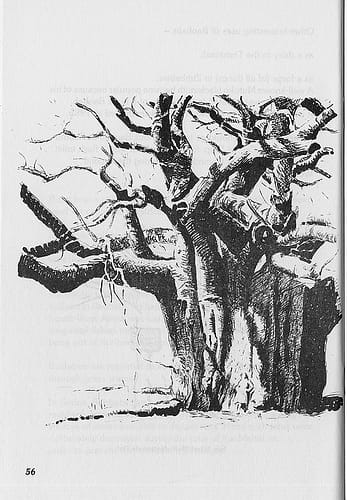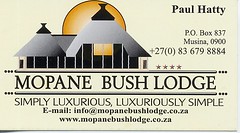There's Peace in Baobabwe

Baobab Trail near Tshipise northern Transvaal Height 24m (79 ft), Circumference 23m (75 ft), water content 200 tonnes (441000 lbs), Wood 50 tonnes (110000 lbs) One of many drawings by Chatty.
There’s Peace in Baobabwe
I remember having lunch at Parliament House in Salisbury when my Dad was a backbencher in Sir Edgar Whitehead’s government in 1958. Mr. Cyril Hatty, the Minister of Finance, cut a fine figure. He was tall, bespectacled, with the perfectly folded white triangle of his handkerchief sticking out of his breast pocket. Sir Edgar, a brilliant bachelor, almost deaf and almost blind, relied on Mr. Hatty as his right-hand man. He was later knighted for services to the country.
There were other sides to Mr. Hatty that we didn’t see then. In semi-retirement, with his elder son, they turned their hands to mixed farming near Norton. Eventually, he withdrew to a dimension called Baobabwe to paint and write under the pen name Chatty.
There’s Peace in Baobabwe
Chatty’s little book There’s Peace in Baobabwe, published in 1987, is still in print today.
Baobabwe sprawls south of the Sahara desert, wherever baobab trees grow, in hot dry lowland areas. Madagascar and Australia are outposts of Baobabwe, where they were growing before the land mass Gondwanaland split over a hundred million years ago. Individual specimens like the one Livingstone estimated at over 4000 years old are not uncommon. These old giants we can see today were in middle age at the time Christ was born: the oldest living things in the world.
Chatty details the baobab’s place in geological time and the four stages of development from seedlings to maturation, flowering and pollination, fruiting and seed distribution.
He explains how these trees become naturally hollowed out. They have been made to serve as a bus shelter, church meeting place, Mosque Swallow nesting site, prison, blacksmith’s forge, and flush toilet.
In the waterless wild the hollows store water. Many birds and animals have a symbiotic relationships with the tree. The tree provides many remedies and survival foods from its different parts for many tribes.
Chatty poses a lot of questions for us to ponder, and includes a suggested reading list. In an aftword he speculates about scientific discoveries and gives us a reading list.
The book has lovely illustrations, and sage advice from baobabs.
Contact Sir Cyril’s son Paul Hatty for a copy: info@mopanebushlodge.co.za
Very many thanks Bob Atkinson and Paul Hatty for sharing this gem of a book with me.

